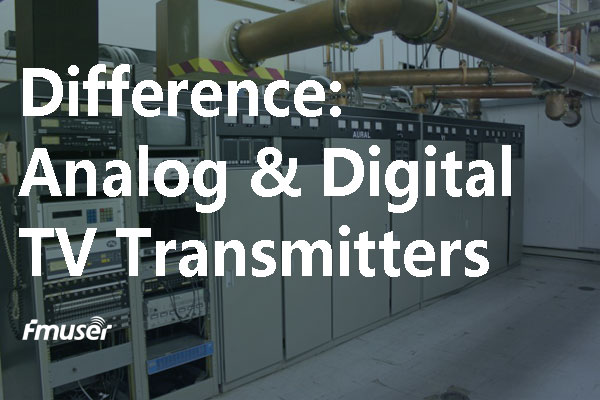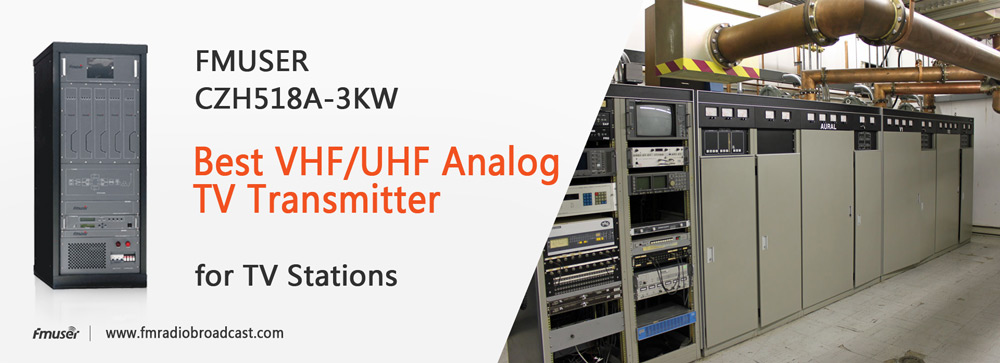
Hot tag
Popular search
Analog & Digital TV Transmitter | Definition&Difference

Since the advent of the digital TV signal, more and more broadcasting companies gradually decreased the power of full-power analog TV transmitters and use digital TV transmitters more and more due to various advantages of digital technology. Here comes the question: What are the different characteristics between the analog TV transmitter and the digital TV transmitter?
Sharing is Caring!
Content
- Content
- Definition of TV Transmitter
- Differences between Analog&Digital TV Transmitter
- How to Choose the Best TV Transmitter?
- FAQ
- Conclusion
Definition of TV Transmitter
A TV transmitter is an electronic device that radiates radio waves, which carries the video signal representing a dynamic image and the audio signal synchronized with it. It will be received by a television receiver and displays the image on the screen and emit a corresponding sound. Its working frequency is limited to VHF and UHF frequency bands, and its working power ranges from 5W to 10kW. It is often used in the field of television broadcasting like tv stations.
TV transmitters transmit radio waves in 2 ways:
- Analog transmission - Image and sound information are transmitted through an analog signal modulated onto a radio carrier. The modulation mode of audio is FM and that of video is AM.
- Digital transmission - Images and sounds are transmitted through digital signals "1" and "0".
The two transmission ways result in different aspects of analog TV transmitter and digital TV transmitter. These differences will be described in detail in the following.
Differences between Analog&Digital TV Transmitter
As mentioned above, the different ways of transmitting signals are the fundamental reason for the differences between the analog TV transmitter and the digital TV transmitter in different aspects, which are mainly in 4 aspects.
The Capacity of TV channels
Analog signals need to occupy a wide frequency band. In the beginning, FCC divides every 6MHz into one channel among the allowed frequency band, and one channel accommodates one TV channel. Therefore, the analog TV transmitter broadcasts a limited amount of TV channels.
After the adoption of the digital TV transmitter, although the allowed frequency band and channel bandwidth are as same before, the digital signal requires a lower bandwidth. Now a 6MHz channel can accommodate 3-6 TV channels. Therefore, the digital TV transmitter can transmit more TV channels.
Signal Transmission
Because the analog TV transmitter uses FM modulation and AM modulation, while the digital TV transmitter uses the digital signal represented by 1 and 0. Therefore, in terms of signal transmission, digital TV transmitter has these characteristics:
- It can transmit signals over a long distance without signal distortion, ensuring digital and sound quality.
- The Digital TV transmitter can transmit higher definition video image quality and clearer sound.
- The digital TV transmitter supports the transmission of edited pictures, such as changing the resolution of the picture in a certain part, adding additional text, animation, etc. to enrich the image.
The digital TV transmitter can transmit more interesting TV programs to the audience. It is the digital technology that announces TV broadcasting enters the HDTV era.
Signal Strength
In analog signal broadcasting, the television receiver doesn't require a high strength of radio signal transmitted by the analog TV transmitter. Even with a limited radio signal strength can the television receiver play the image and sound, just going along with the snowflakes and noise.
On the other side, the digital television receiver requires the signal strength to be upper a certain level, then it can play the image and sound. But if the signal strength is not enough, there is only a dark left.
Buying Costs
The analog TV transmitter and analog TV do not have high requirements for the other relevant equipment. People can buy a set of analog tv equipment at a low cost. However, digital broadcasting has a higher requirement for the relevant equipment because of more complicated technology, which means the operator and audience have to pay a lot to update their TV equipment like digital TV transmitter, digital TV antenna, digital TV receiver, and so on.
Due to the different working modes of digital TV transmitter and analog TV transmitter, it has brought various impacts to operators and viewers, including cost, signal transmission quality, viewing experience, program content design, and so on.
How to Choose the Best TV Transmitter?
When selecting a TV transmitter, in addition to selecting whether it is a digital TV transmitter or an analog TV transmitter, it is also necessary to consider its working frequency range, the separation between audio frequency and video frequency, and bandwidth.
Enough Radio Frequency
It means the available radio frequency range for the TV transmitter. The radio frequency ranges allowed currently for the TV transmitter are HF, VHF, and UHF. The following are the frequency band in detail:
- 54 to 88 MHz for channels 2 to 6
- 174 to 216 MHz channels 7 to 13
- 470 to 890 MHz for UHF channels 14 to 83
The TV transmitter you choose should be able to work in the above three frequency bands.
High Separation of Audio Frequency and Video Frequency
According to U.S. law, the centre frequency of the aural carrier must be 4.5 MHz ± 5 kHz above the frequency of the visual carrier at the output of the modulating or processing equipment of a cable television system.click here
Wide Bandwidth
It refers to the frequency range of radio signals transmitted by the TV transmitter, that is, the bandwidth it uses. The wider the bandwidth, the more TV channels can be carried.
The above is the international plan of broadcasting standards formulated by ITU, which pointed out that the most important numbers of the TV transmitter are the Frequency separation between auditory and visual carriers, Radio Frequency, and Bandwidth. If you need to update or buy TV transmitters, please look for a reliable radio broadcasting equipment supplier like FMUSER, who can provide you with high-quality, low-cost digital&analog TV transmitters and related equipment, such as TV antennas and so on. If you are interested, click here to learn more.
 FMUSER CZH518A-3KW Professional VHF/UHF Analog TV Transmitter for TV stations
FMUSER CZH518A-3KW Professional VHF/UHF Analog TV Transmitter for TV stations
Frequently Asked Questions
1. Q: How Far Can a TV Transmitter Broadcast?
A: It can broadcast a distance of around 40 - 60 miles.
A TV transmitter can transmit on frequency channels in the VHF, and UHF bands. Since radio waves of these frequencies travel by line of sight, they can travel a distance of 40–60 miles depending on the height of the transmitter station.
2. Q: What Can Interfere with the TV Signals?
A: The obstacles around the TV transmitter would interfere with the TV signals quality.
In general, obstructions are those between your local broadcast towers and your Over-the-Air TV antenna that can interfere with the TV signals, including trees, mountains & valleys, large buildings, and so on.
3. Q: How are TV Signals Transmitted?
A: They are transmitted in the form of radio waves to the air.
The TV signal is carried by cable to an antenna, which is often on a high mountain or building. The signals are broadcast through the air as radio waves. They can travel through the air at the speed of light.
4. Q: What is the Frequency Band of a TV Transmitter?
A: It can broadcast on the VHF and UHF bands.
A TV transmitter can transmit in VHF and UHF bands. The following are the frequency band in detail:
- 54 to 88 MHz for channels 2 to 6
- 174 to 216 MHz channels 7 to 13
- 470 to 890 MHz for UHF channels 14 to 83
Conclusion
Speaking of which, we know that analog TV transmitters and digital TV transmitters can meet different requirements. Do you need to buy TV transmitters? FMUSER is a reliable provider of radio broadcasting equipment and solutions, which can provide you with a complete TV transmitter package including analog&digital TV transmitters for sale, matched TV antennas for sale. please contact FMUSER. We strive to make our customers feel heard and understand.
Also Read
Tags
Contents
Related Articles
CONTACT US


FMUSER INTERNATIONAL GROUP LIMITED.
We are always providing our customers with reliable products and considerate services.
If you would like to keep touch with us directly, please go to contact us





